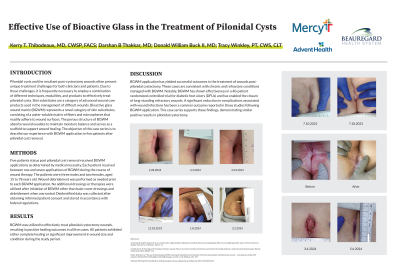Case Series/Study
(CS-163) Effective Use of Bioactive Glass in the Treatment of Pilonidal Cysts
Friday, May 2, 2025
7:45 PM - 8:45 PM East Coast USA Time

Donald Buck, MD; Darshan Thakkar, MD; Tracy Winkley, PT, CWS, CLT – Wound Specialist/Clinic Director, Wound Healing Center, Beauregard Health System
Introduction: Pilonidal cysts and the resultant post-cystectomy wounds often present unique treatment challenges for both clinicians and patients. Due to these challenges, it is frequently necessary to employ a combination of different techniques, modalities, and products to effectively treat pilonidal cysts. Skin substitutes are a category of advanced wound care products used in the management of difficult wounds. Bioactive glass wound matrix (BGWM) represents a novel category of skin substitutes, consisting of a water-soluble matrix of fibers and microspheres that readily adhere to wound surfaces. The porous structure of BGWM absorbs wound exudate to maintain moisture balance and serves as a scaffold to support wound healing. The objective of this case series is to describe our experience with BGWM application in five patients after pilonidal cyst removal.
Methods: Five patients status post pilonidal cyst removal received BGWM applications as determined by medical necessity. Each patient received between one and seven applications of BGWM during the course of wound therapy. The patients were three males and two females, aged 15 to 78 years old. Wound debridement was performed as needed prior to each BGWM application. No additional dressings or therapies were utilized after initiation of BGWM other than basic cover dressings and debridement when warranted. De-identified data was collected after obtaining informed patient consent and stored in accordance with federal regulations.
Results: BGWM was utilized to effectively treat pilonidal cystectomy wounds, resulting in positive healing outcomes in all five cases. All patients exhibited either complete healing or significant improvement in wound size and condition during the study period.
Discussion: BGWM application has yielded successful outcomes in the treatment of wounds post-pilonidal cystectomy. These cases are consistent with chronic and refractory conditions managed with BGWM. Notably, BGWM has shown effectiveness in a 40-patient randomized controlled trial for diabetic foot ulcers (DFUs) and has enabled the closure of long-standing refractory wounds. A significant reduction in complications associated with wound infections has been a common outcome reported in these studies following BGWM application. This case series supports these findings, demonstrating similar positive results in pilonidal cystectomy.
Methods: Five patients status post pilonidal cyst removal received BGWM applications as determined by medical necessity. Each patient received between one and seven applications of BGWM during the course of wound therapy. The patients were three males and two females, aged 15 to 78 years old. Wound debridement was performed as needed prior to each BGWM application. No additional dressings or therapies were utilized after initiation of BGWM other than basic cover dressings and debridement when warranted. De-identified data was collected after obtaining informed patient consent and stored in accordance with federal regulations.
Results: BGWM was utilized to effectively treat pilonidal cystectomy wounds, resulting in positive healing outcomes in all five cases. All patients exhibited either complete healing or significant improvement in wound size and condition during the study period.
Discussion: BGWM application has yielded successful outcomes in the treatment of wounds post-pilonidal cystectomy. These cases are consistent with chronic and refractory conditions managed with BGWM. Notably, BGWM has shown effectiveness in a 40-patient randomized controlled trial for diabetic foot ulcers (DFUs) and has enabled the closure of long-standing refractory wounds. A significant reduction in complications associated with wound infections has been a common outcome reported in these studies following BGWM application. This case series supports these findings, demonstrating similar positive results in pilonidal cystectomy.

.jpg)